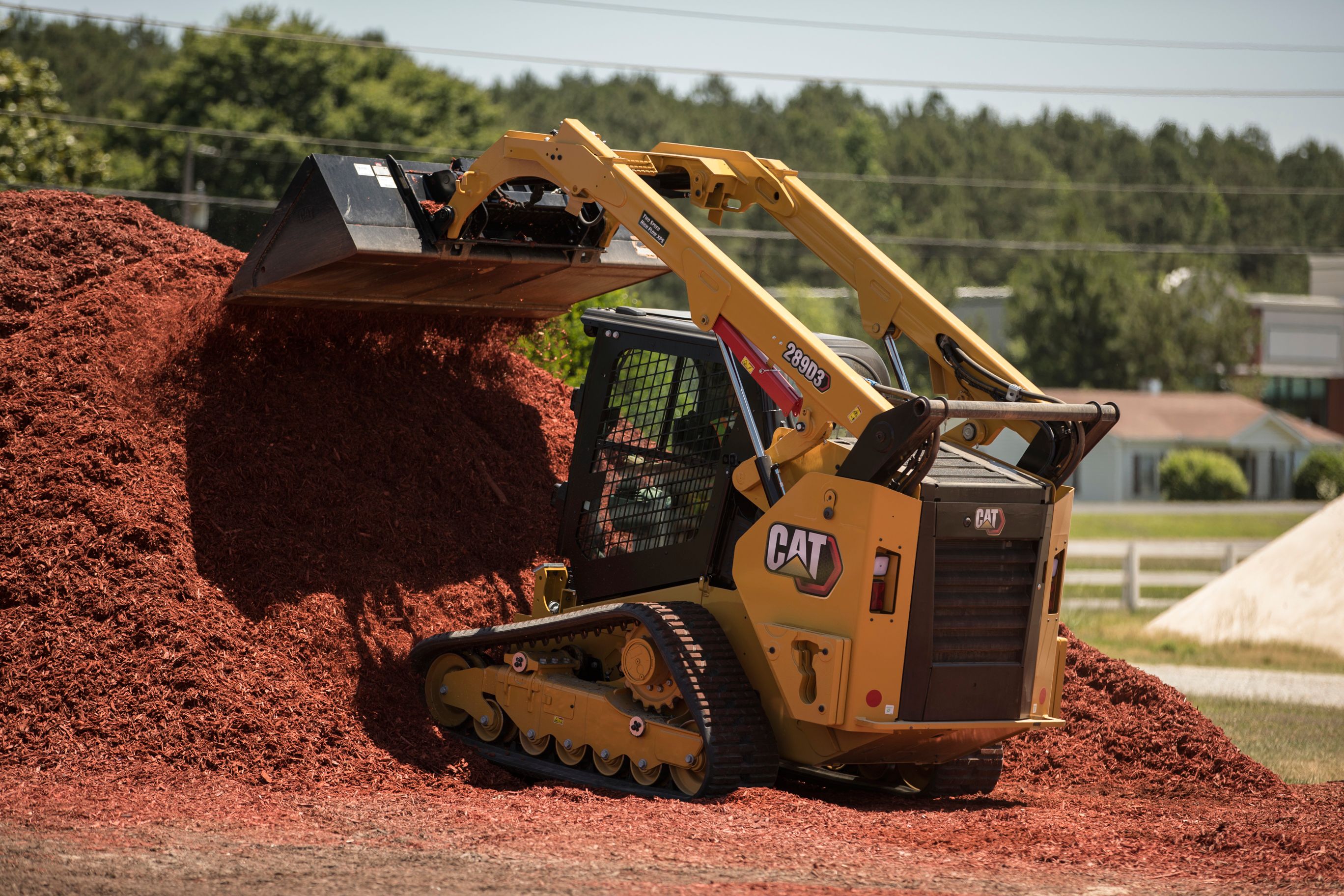

Sign In
Welcome! Sign In to personalize your Cat.com experience
If you already have an existing account with another Cat App, you can use the same account to sign in here
Register Now
One Account. All of Cat.
Your Caterpillar account is the single account you use to log in to select services and applications we offer. Shop for parts and machines online, manage your fleet, go mobile, and more.
Account Information
Site Settings
Security
Author: Small Business Expert | May 25, 2021 | Topic: Used Equipment
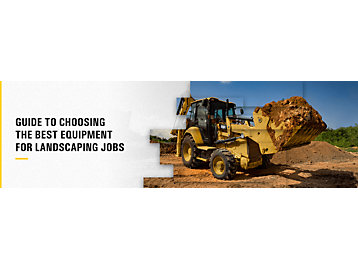
When you're trying to grow your landscaping business, you need a landscaping equipment guide to help you find the right equipment for your needs. By knowing more about the best pieces of equipment and attachments for landscaping, you can better determine which ones will provide the most value for your company. Making the right equipment choices can help your crews increase their efficiency and take on tougher jobs.
As you learn more about the top equipment and attachments for landscaping, you may be interested in exploring the advantages of buying used equipment and the value of choosing Cat Used for your equipment requirements.

7 Best Types of Equipment for Landscaping
When you're looking for landscaping equipment, you'll have lots of options to choose from. For example, you'll often see skid steer loaders, backhoe loaders, dozers and mini excavators on an equipment list for a landscape business. As you build your landscaping fleet, it's a good idea to be aware of the main types of landscaping equipment and their differences.
Below are the seven best types of heavy equipment for landscaping:
1. Skid Steer Loaders
Skid steer loaders are some of the smallest pieces of landscaping equipment, providing a great deal of versatility and maneuverability on a work site. While small, the skid steer still packs a punch, making it well-suited for plowing and earthmoving tasks. These machines can scoop, push, plow and lift a variety of materials, like snow, debris, soil and mulch. They're compatible with many attachments, meaning you can outfit them for various jobs.
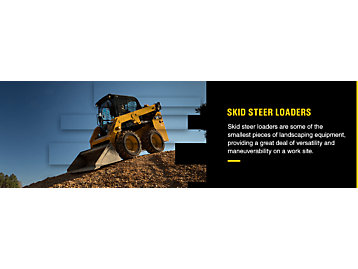
Many companies prize skid steers for their ability to precisely turn in their own tracks. Due to their maneuverability and size, they can navigate tight work sites where larger machines might not fit. They're also fairly light, making it possible for drivers to pull them to a work site behind a pickup truck.
2. Compact Track and Multi-Terrain Loaders
Compact track and multi-terrain loaders provide the size, power and versatility of skid steers, but they come with rubber tracks. They're sometimes referred to as tracked skid steers due to their many similarities. Tracks give these machines the ability to operate on soft ground. The light design and tracks are perfect for projects where you need minimal ground disturbance.
Landscapers regularly use compact track and multi-terrain loaders for varying tasks, such as smoothing, plowing, pushing, scooping and lifting. They're attachment-friendly, and these attachments can help crews perform more tasks, like filling, trenching, raking, grading and tilling. Due to their small size, they can navigate tighter work sites with ease.
3. Backhoe Loaders
Backhoe loaders combine three machines in one — a loader, tractor and backhoe. At the front, it features a loader blade that is perfect for earthmoving tasks. On the rear, it has a backhoe designed to dig. The backhoe loader's overall structure resembles a tractor, giving it the ability to navigate rough terrain easily. When the backhoe is in use, the operator can utilize stabilizing legs to maintain the backhoe loader's stability and reduce strain from the downward digging's force.
With this multifaceted design, backhoe loaders regularly push, smooth, plow, lift and scoop loose or heavy landscaping materials, like dirt, debris, snow and soil. Since they're outfitted with a backhoe, they can dig through the hard surfaces. You can often see landscapers using the backhoe to dig trenches and ditches and then fill them back in with the loader.
4. Wheel Loaders and Compact Wheel Loaders
Wheel loaders are designed for earthmoving tasks, like moving and lifting materials. They tend to be more powerful than skid steers and compact track loaders, providing companies greater capacity for earthmoving work. They can lift and move more materials, helping you complete projects faster with a front loader shovel.
A full-sized wheel loader is a great choice for larger landscaping jobs, while compact wheel loaders are more suitable for smaller work sites, especially if the space is hard to navigate. Typically, any kind of wheel loader pushes and loads materials like snow, gravel, sand and soil. These loaders come with wheels crafted to stabilize the loader while moving over uneven terrains. They're also compatible with several attachments, allowing companies to outfit them for a diverse range of jobs.
5. Telehandlers
Sometimes called telescopic handlers, telehandlers feature articulated or telescopic booms designed to lift materials. They're essentially a crane-forklift hybrid that make it easier for crews to lift heavy materials. In landscaping, operators often use them to assist with tree removal and care. Since they feature a sturdy frame and rugged wheels, they can handle rough terrain. Smaller telehandlers can also navigate tighter spaces.
You'll regularly find telehandlers used for tree care, as the arms allow operators to access out-of-reach tree parts and prune limbs. Companies can outfit telehandlers with brush cutting and broom attachments to assist with clearing lots and buckets for lifting debris and earth. You can find this equipment with various load capacities, reach lengths and reach heights.
6. Small and Mini Hydraulic Excavators
Small and mini hydraulic excavators help operators with landscaping excavating tasks, like planting and trenching. Excavators come with a boom featuring a bucket at the end of it designed for digging into hard ground. Companies commonly use these machines to hardscape, plant trees, dig trenches and holes, and install water features.
Since these types of excavators are smaller, they can fit on tighter work sites, navigating them with ease. Landscapers often employ them to work along retaining walls or between buildings, where larger excavators can't fit. If you're digging a swimming pool or giant pond, you may want to use a larger excavator if the work site allows it. Excavators are compatible with many attachments, like hammers, blades, backhoes and compactors.
7. Dozers
Dozers are machines featuring a large metal blade to push materials around a work site, like gravel, soil and sand. Since they can push materials, operators regularly use them to grade and clear land. Operators also use them to build berms. Dozers rely on wide rotating twin tracks to distribute their weight more evenly and decrease the pressure the machine places on the ground. This allows dozers to work on soft terrain.
You can find dozers in varying sizes, so you can match the size of your equipment to the needs of your landscaping terrain, like smaller residential projects or larger commercial jobs. Companies regularly swap out blades on the dozer to better serve their project's requirements.
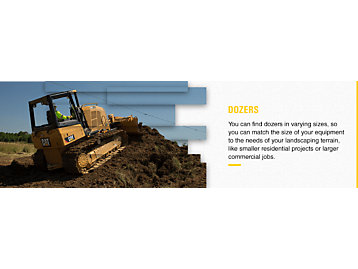
10 Best Landscaping Equipment Attachments
Any equipment guide for landscaping should include the top attachments for landscaping machinery. Landscaping attachments can increase your equipment's capabilities, allowing you to complete more jobs with a single piece of equipment. Find out more about the ten best equipment attachments for landscaping below:
- Couplers: One of the most vital pieces of landscaping equipment is the coupler, as it's designed to help operators switch out other attachments easily and quickly. You can often find couplers for loaders, excavators and backhoes.
- Mulchers: Mulchers are incredibly useful for landscapers, as they cut up overgrowth and vegetation, converting them into mulch. These mulchers come in a variety of configurations that are perfect for different sizes of mulching jobs and compatible with various pieces of heavy equipment.
- Brushcutters: When a work site has small tree trunks and dense weeds, a brushcutter is perfect for the job. These attachments feature metal blades to cut through tough vegetation and come in various sizes.
- Stump grinders: Stump grinders help landscapers remove stumps from work sites. These attachments make stump removal faster, giving your team more time to handle other tasks.
- Landscape tillers: Landscapers use landscape tillers to blend and break up soil. Operators rely on them to prepare seedbeds and grade or level soil.
- Snowplows: When the winter months hit and the snow piles up, many landscapers use snowplows. These attachments help operators quickly clear snow from parking lots, driveways and roads.
- Rakes: A rake attachment is a tool used for clearing land and piling leaves and brush. You can find them in various sizes and types to best suit your project's requirements.
- Augers: Landscapers who need to drill holes turn to augers. They're compatible with multiple types of machines, and many operators use them for post-hole digging.
- Wheel saws: When you attach a wheel saw to your equipment, you can precisely cut tough materials. They're usually compatible with compact track loaders and skid steers.
- Shears: Shears are designed for cutting raw materials in an effective and efficient manner, making them an excellent choice for landscaping tasks.
Why Should You Buy Used Landscaping Equipment?
Buying used equipment can help your company secure reliable landscaping tools at a lower price so you can expand your fleet for less money. Used equipment also features a broader selection, has less depreciation and offers faster purchasing. Below are some of the top benefits of buying used equipment:
- Low price point: Used equipment typically comes at a lower price point. As a result, you don't have to have as much cash flow available to invest in high-quality equipment. This makes used equipment much more accessible for companies looking to control costs.
- Wide selection: Used equipment often offers a broader selection. You can choose from various generations and model years of landscaping equipment, helping you find the perfect machine for your company's needs. This wide selection of past models can also allow you to purchase equipment your operators are already familiar with, reducing training times after adding equipment to your fleet.
- Large fleets for fewer costs: Since landscaping equipment comes at lower costs, you can use the money you save to purchase other pieces of equipment. This ability to access more equipment with less money allows you to grow your fleet fast, increasing your ability to take on more jobs and increase your team's efficiency.
- Less depreciation: When you purchase used landscaping equipment, it has usually already undergone its steepest deprecation period. Since there's less depreciation, you can expect your machinery to hold its value longer. When you decide to sell it, you can recoup much of your initial investment.
- Fast access to machinery: Used machinery is usually available right when you need it, without the need for it to be manufactured. As long as the dealer has it in stock, you can purchase it quickly and sometimes have it delivered to your work site. This fast access allows you to adjust rapidly to a new project with requirements your current fleet can't handle.
Why Buy Landscaping Equipment From Cat Used?
One of the best tips for choosing landscaping equipment is to buy from a reputable dealer. Many buyers turn to Cat Used for our trusted reputation and the high-quality Cat® machinery our dealers provide. As you look to expand your fleet, learn more about the benefits of buying landscaping equipment from Cat Used:
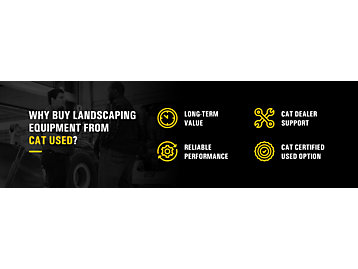
- Long-term value: When you purchase used landscaping equipment from Cat Used dealers, you can expect your Cat machinery to hold its value. Since Cat equipment has a reputation for its rebuildability and longevity, you can likely recoup a portion of your investment when you decide to sell your equipment or trade it in.
- Cat dealer support: Once you've purchased used equipment from Cat Used dealers, you can expect high-quality support for your machinery in the long term. Your local dealer can help you with after-sale support, answering your questions and providing compatible parts when your machinery needs repairs.
- Reliable performance: You can be confident Cat equipment from Cat Used will provide reliable performance long after purchase. Many of our dealers appraise, clean and inspect used machinery before offering it for sale, ensuring that you receive a durable machine and know as much information about the equipment you're buying as possible.
- Cat Certified Used option: If you want low-hour and well-maintained landscaping equipment, Cat Certified Used equipment is for you. Any Cat Certified Used machine is inspected thoroughly, serviced and backed by a standard equipment protection plan. Due to the rigorous selection requirements, you can expect to receive quality performance at an affordable price.

Turn to Cat Used for Your Landscaping Equipment Needs
After reviewing our guide to landscaping equipment and the benefits of buying from Cat Used, you're ready to find the used landscaping equipment you need from a Cat Used dealer near you. Take a moment to browse our dealers' inventory of used Cat landscaping equipment today.
If you want to learn more about a piece of equipment our dealers have for sale, find and contact your local Cat dealer. For times when the equipment you want isn't available, you can sign up for email alerts that notify you as soon as it becomes available.
